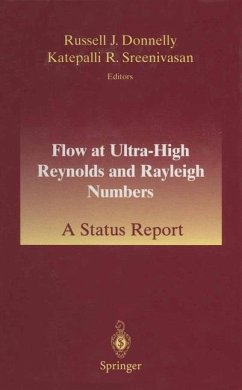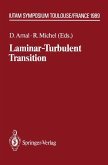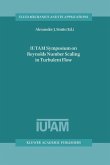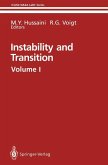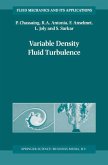Flow at Ultra-High Reynolds and Rayleigh Numbers
A Status Report
Herausgegeben:Donnelly, Russell J.; Streenivasan, Katepalli R.
Flow at Ultra-High Reynolds and Rayleigh Numbers
A Status Report
Herausgegeben:Donnelly, Russell J.; Streenivasan, Katepalli R.
- Broschiertes Buch
- Merkliste
- Auf die Merkliste
- Bewerten Bewerten
- Teilen
- Produkt teilen
- Produkterinnerung
- Produkterinnerung
Scientists have learned to use liquid and gaseous helium to overcome the limitations imposed by the usual wind and water tunnels for testing the performance of aircraft or the behavior of the atmosphere. This book covers fundamental studies of the turbulence problem, practical applications of turbulence, superfluid turbulence, cryogenic turbulence research, and new types of miniature flow instrumentation, all which are crucial for high Reynolds number research. This state-of-the-art presentation will interest physicists in fluid dynamics, engineers working with turbulent flows, and naval and aerospace engineers testing realistic parameter ranges.…mehr
![The Mathematical Theory of Turbulence The Mathematical Theory of Turbulence]() M. M. StanisicThe Mathematical Theory of Turbulence38,99 €
M. M. StanisicThe Mathematical Theory of Turbulence38,99 €![Laminar-Turbulent Transition Laminar-Turbulent Transition]() Laminar-Turbulent Transition79,99 €
Laminar-Turbulent Transition79,99 €![IUTAM Symposium on Reynolds Number Scaling in Turbulent Flow IUTAM Symposium on Reynolds Number Scaling in Turbulent Flow]() Alexander J. Smits (Hrsg.)IUTAM Symposium on Reynolds Number Scaling in Turbulent Flow154,99 €
Alexander J. Smits (Hrsg.)IUTAM Symposium on Reynolds Number Scaling in Turbulent Flow154,99 €![Instability and Transition Instability and Transition]() Instability and Transition77,99 €
Instability and Transition77,99 €![Tubes, Sheets and Singularities in Fluid Dynamics Tubes, Sheets and Singularities in Fluid Dynamics]() K. Bajer / H.K. Moffatt (Hgg.)Tubes, Sheets and Singularities in Fluid Dynamics116,99 €
K. Bajer / H.K. Moffatt (Hgg.)Tubes, Sheets and Singularities in Fluid Dynamics116,99 €![Dissipative Structures in Transport Processes and Combustion Dissipative Structures in Transport Processes and Combustion]() Dissipative Structures in Transport Processes and Combustion39,99 €
Dissipative Structures in Transport Processes and Combustion39,99 €![Variable Density Fluid Turbulence Variable Density Fluid Turbulence]() P. ChassaingVariable Density Fluid Turbulence147,99 €
P. ChassaingVariable Density Fluid Turbulence147,99 €-
-
-
- Produktdetails
- Verlag: Springer / Springer New York / Springer, Berlin
- Artikelnr. des Verlages: 978-1-4612-7464-3
- Softcover reprint of the original 1st ed. 1998
- Seitenzahl: 488
- Erscheinungstermin: 12. Dezember 2011
- Englisch
- Abmessung: 235mm x 155mm x 27mm
- Gewicht: 733g
- ISBN-13: 9781461274643
- ISBN-10: 1461274648
- Artikelnr.: 36115688
- Verlag: Springer / Springer New York / Springer, Berlin
- Artikelnr. des Verlages: 978-1-4612-7464-3
- Softcover reprint of the original 1st ed. 1998
- Seitenzahl: 488
- Erscheinungstermin: 12. Dezember 2011
- Englisch
- Abmessung: 235mm x 155mm x 27mm
- Gewicht: 733g
- ISBN-13: 9781461274643
- ISBN-10: 1461274648
- Artikelnr.: 36115688

